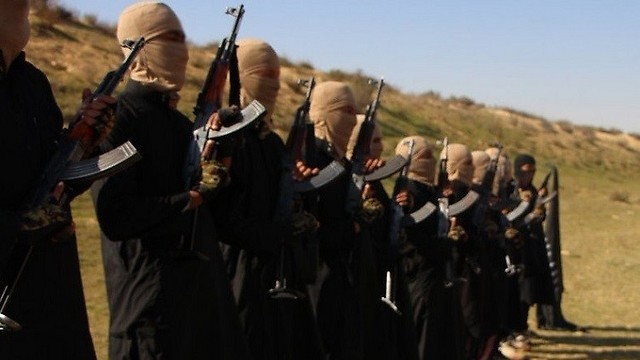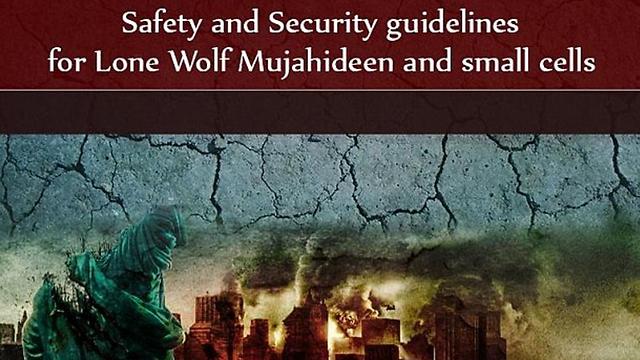ISIS has managed to terrify millions of people all over the world. With Europe worried and Saudi Arabia sounding its war drums- what do we really know about Islamic State, what types of weapons does it possess, and how much should Israel worry? Here are the myths, the successes, and the losses of the group the world calls “ISIS.”
The terror organization known as Islamic State has killed tens of thousands, and has managed to terrify millions the world over. It has had several dubious titles bestowed upon it, and has been recognized as the “richest terrorist organization in the world.” But how much do we really know about them, and how much do we need to worry about them?
Myth 1: ISIS is a new organization
The infamous terror organization, although only making its first appearance in Israeli headlines a few years ago, is not at all a new organization. In fact, we can trace its beginnings to 1999, when the Jordanian terrorist Musab al-Zarqawi founded the group Jama’at al-Tawhid wal Jihad. Since then, the organization has had many incarnations, and eventually became the so-called al-Qaida in Iraq, which started to to operate following the US invasion of Iraq in 2003. Even the name ISIS has already become obsolete, but we’ll get to that later.
Under the name al-Qaida in Iraq the organization swore allegiance to the leadership of al-Qaida, and started to carry out attacks in its name. Even then, the group wasn’t afraid to use extreme measures, causing the central al-Qaida leadership to be furious. They willfully killed Muslims, a red line for an organization which killed thousands of Americans without mercy in the attack on the World Trade Center towers on September 11 2001. Indeed, several years later, the two groups separated from each other, for, amongst other reasons, the fighting in Syria.

The period with al-Zarqawi at the helm ended in 2006, when he was assassinated in a US bombing, and Abu-Ayyub al-Masri replaced him, before he too was killed four years later; but not before he changed the name to Islamic State in Iraq.”
Into al-Masri’s shoes stepped the current leader of ISIS, Abu-Bakr al-Baghdadi- or, as he was originally known- Ibrahim Awwad Ibrahim al-Badri al-Samri, with a doctorate in Islamic studies He was born in 1971, and his relatives described him as someone who “didn’t speak a lot”.

A high ranking US intelligence official described Baghdadi as “the real heir to Osama bin Laden. He is crueler, and more anti-American than Ayman a-Zawahiri, the current head of al-Qaida.”
Once al-Baghdadi became the head of the organization in 2010, ISIS began to spread to Syria, and changed its name to the Islamic State in Iraq and Sham (the Arabic acronym, Daesh, stands for the words “Dawlat al-Eslamiyye fi al-Iraq wal Shams).
The appointment of al-Baghdadi signaled a turning point in the policies of the organization, which turned more global, became more accessible, and took on more state functions. The peak came in 2014, when al-Baghdadi declared the establishment of the Caliphate, appointed himself Caliph, and changed the name of the organization to “Islamic State”- with no geographic connection and whose goal is international. With the declaration of the rise of the Caliphate, al-Baghdadi also clarified that the raison d’etre of the organization is “global domination,” meaning that all Muslims must obey and join the effort.
The terrorist organization has since turned into a functioning state- with an official currency, education system, judiciary system, banks, health services, electricity, and street cleaners. They apply Sharia Islamic law to the areas which they capture, and give non-muslims the option to either convert to Islam, pay Jizya (a tax for non-muslims), or die.
Al-Baghdadi has also ushered in a period of economic prosperity, primarily from the oil fields which the organization controls in Iraq and Syria. They have been so prosperous, that the US treasury has classified it as the “world’s richest terrorist organization,” worth approximately two billion dollars. In September of 2014, the US National Counterterrorism Center declared that ISIS controlled 201 thousand square kilometers in Syria and Iraq- an area equal to the size of the UK – and thus ruled ten million people.
Myth number two: the source of the majority of ISIS’s revenue is from oil
This common assumption was correct until recently, when the organization was in control of several oil fields in Iraq and Syria, which earned, according to different documents, between $500-600 million a year. ISIS sold the gas to anyone who requested, including to its enemies- from different opposition forces to even the government of Bashar al-Assad. They were assisted by smuggling networks which had already been in place since the 1990’s, when Saddam Hussein tried to circumvent the international sanctions placed on the export of his gas.

With the beginning of the coalition strikes led by the US, ISIS has lost a significant amount of territory (according to reports, ISIS now controls between an third and a half of the territory it controlled in 2014), and in the campaign conducted last October, ISIS lost most of the oil infrastructure it controlled. From producing between 30 to 80 thousand barrels of oil a day, it now only produces 25 thousand barrels a day. Even by early 2015, The Pentagon reported that “oil is no longer a primary source of income for ISIS,” and the US Treasury estimated that the income from oil went down to only $100 million a year. This is due to the destruction of oil infrastructure, the sharp decline in oil prices, and the shortage of experts who know how to refine the oil (most of them deserted or were killed in coalition airstrikes).
In order to cover their economic losses, ISIS has been searching for alternate sources of revenue, such as by increasing taxes on the population in areas they control, through extortion, stealing cash from banks, selling antiquities, selling sex slaves, selling crops, and even ransom and kidnapping.
Myth 3: ISIS is sweeping across the Muslim world
Although there are approximate 30 terror organizations around the world who pledged their allegiance to ISIS, and have granted them footholds in countries such as Uzbekistan, Nigeria, the Sinai, and the Philippines amongst others, most of these organizations have maintained their groups’ autonomy, and continued to concentrate their resources on fighting against their local governments.
Additionally, the majority of Muslim nations have come out against ISIS, and have stated that they do not represent “true Islam.” Just this last December for example, Saudi Arabia declared the formation of a Muslim coalition against ISIS which includes more than 30 countries (this, despite the fact that Saudi Arabia donated lots of money to ISIS at the beginning, primarily out of spite for the Iranians and the Assad regime).
Surprisingly, or perhaps not so, the majority of ISIS’s support comes from groups which originated in the areas ISIS occupies. Excluding the ethnic minorities which suffer from persecution and discrimination, most of the inhabitants of Islamic State enjoy the stability and services provided by the organization, especially after five chaotic years living in a war- wracked country. They also benefit from the money that comes in from oil sales, and the strengthening of the Sunnis in the area.
Among the largest supporters are different Sunni tribes, former Baath party members, former officers in Saddam Hussein’s army, and various jihadist groups. Indeed, ISIS has a military advantage over these groups, but their support for the group is important. The moment these groups no longer support ISIS, it will be much tougher for the organization to operate unimpeded in the areas under its control.
So who is afraid of ISIS? Or: does Israel need to worry?
The terrorist organization had a meteoric rise over the past decade – from a local group to an Islamic State with goals to conquer the world. The last year saw more and more attacks outside of Syria and Iraq, including the Paris terror attacks, the explosion in Dahieh in Lebanon, and the takedown of the Russian plane in Sinai. It seems that the organization is gaining momentum regarding its global goals.
But the US led coalition attacks (and the Russian and Arab coalition strikes as well) are taking their toll: ISIS has lost between a third to half of its territory, its oil and gas exports have been cut significantly, and almost one third of the leaders have already been assassinated. In general, 2015 has seen the deaths of several important people such as Jihadi John, and the head of ISIS in Libya. Just this week, there have been unconfirmed reports that the head of ISIS in Yemen was killed.
Members of the organization feel the strategic losses, and only a month ago it was reported that their salaries will be cut in half, causing many people to leave the ranks of the organization. Additionally, the central bank with most of ISIS’s cash in Mosul was blown up, and the Iraqi army re-captured ISIS’s capital in Iraq – Ramadi.
As for the military capabilities of the organization – the fighting force stands at between 20,000 and 25,000 fighters, and is in possession of a wide arsenal of light weapons, heavy weapons, and even chemical weapons. With that being said, most of the weapons are older, weapons which ISIS “inherited” from the era of the US occupation and from the Soviet era. Some of the weapons are unusable, and some of the weapons not everyone in the organization knows how to use. Therefore, the few planes in ISIS’s possession (six, according to reports) remain unused as there is no one who knows how to fly them.
An American security analyst said on CNBS that most of the weapons that fall into the hands of ISIS are used as “trophy pieces” as opposed to actually getting used in battles, and also because the fighters are usually keen on getting back to their light weapons of choice.
To put this in perspective, the IDF is almost 30 times larger than the entirety of the organization in Syria and Iraq (and that’s without taking into consideration the amount of advanced weapons and its budget), and the number of armed fighters in the US Military is almost 100 times larger.
Moving back to Israel- in the last few months the IDF has been preparing for different scenarios should it have to confront the cruel terrorist organization, and with good reason. With that being said, the Institute for National Security Studies (INSS) has ranked ISIS third in terms of major threats to Israel. Preceding ISIS is the Iranian threat, and the Israeli – Palestinian conflict.
On the northern front, Hezbollah poses a more direct threat than ISIS, and in the south, ISIS in Sinai is fighting primarily against the Egyptian army. Jordan remains relatively stable, and it seems that the eyes of the organization are gazing towards Libya and Saudi Arabia. While lone wolf attacks threaten every nation in the world, it seems that ISIS itself is too deep in the mud in Syria and Iraq to directly threaten Israel.
As reported by Ynetnews
